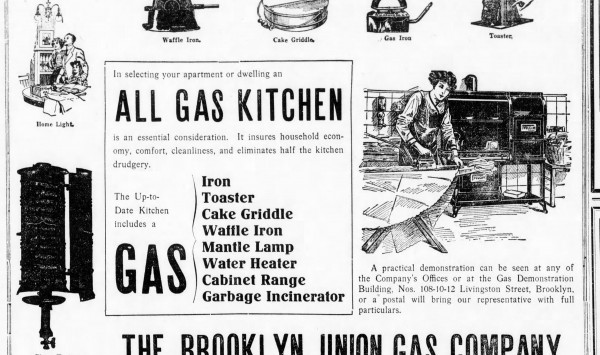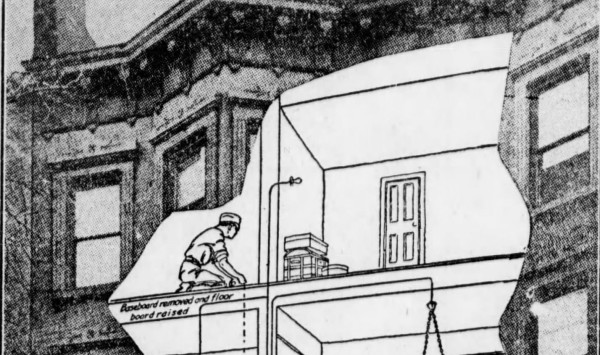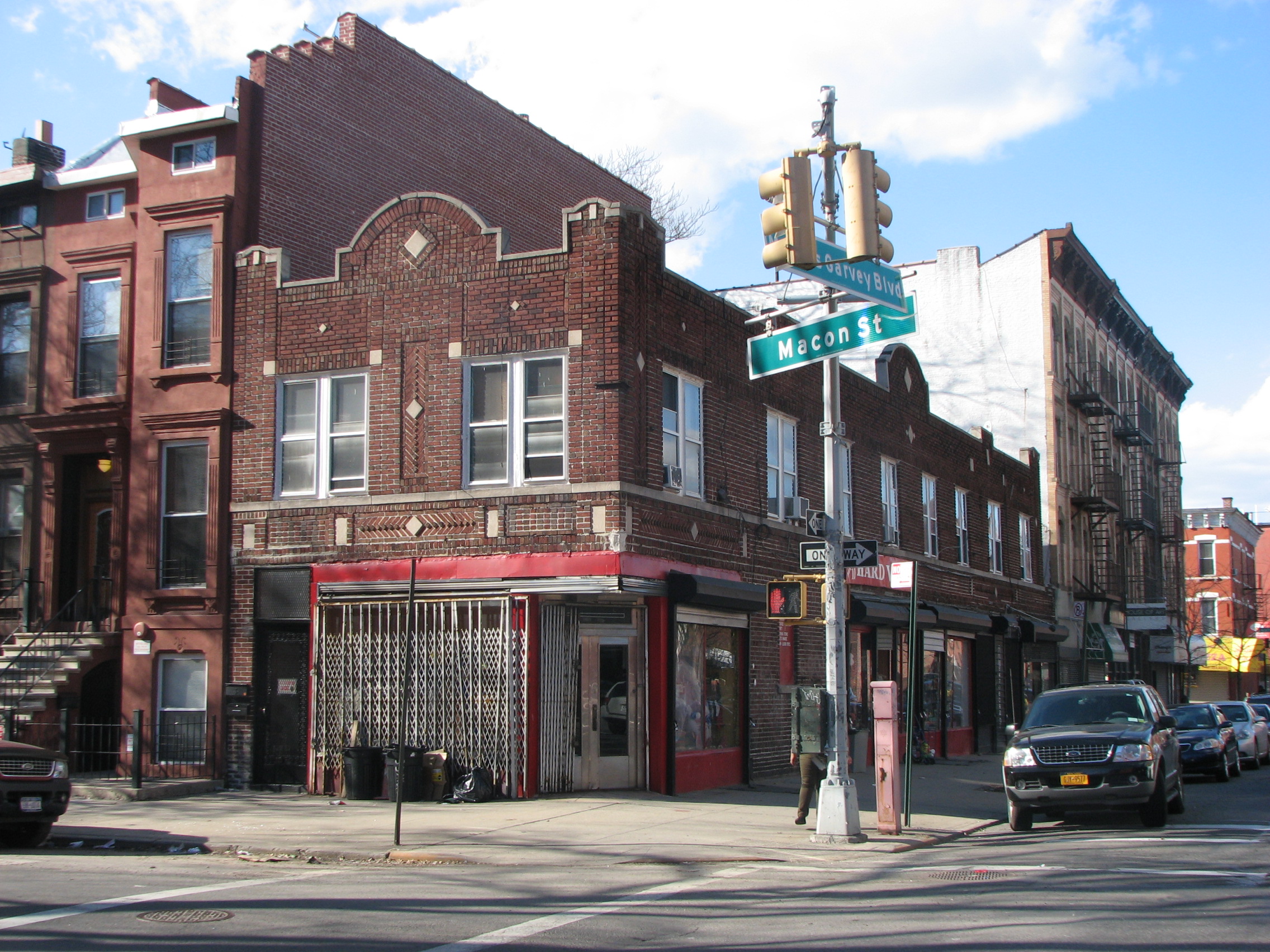BROOKLYN’S ALL GAS KITCHEN! (1914)

******************************************************************************************************************************** Brownstone Detectives investigates the history of our clients’ homes. The story you are about to read was composed from research conducted in the course of one of those investigations. Do you know the history of YOUR house? ******************************************************************************************************************************** Just like today, gas stoves were once pushed onto Americans with a fury. Fueled by ads, lobbying, and massive amounts of money, the Brooklyn gas company told homemakers that gas was “essential” for “economy, comfort, cleanliness,” and guaranteeing an elimination of “half the kitchen drudgery.” Little did homemakers know, at the time, about the future controversy regarding gas as a health concern in the home. THE FUTURE – GAS! O, Brooklyn Union Gas Company! Thanks to you, my wife can be more efficient in the kitchen with the chemical of the future – GAS! Begun in 1825 as the the Brooklyn Gas Light Company, it became Brooklyn Union around 1895, and remained so until the end of the last century when a merger brought about KeySpan. Imagine! Installing, in 1914, a Gas Garbage Incinerator in your brownstone’s kitchen! That year, the Brooklyn Union Gas Company was pushing their gas appliances not only to heads of households, but they were also targeting “Progressive Business Men” to whom they claimed were attending the “special demonstration of gas industrial appliances at the gas industrial show rooms” at 108-10-12 Livingston Street, known as their “Gas Demonstration Building.” At their showrooms they announced, were “gas engine electric generator sets, automatic gas fuel steam boilers, sanitary bakers’ […]
DITCHING YOUR HOME’S OUTDATED GAS (1916)

******************************************************************************************************************************** Brownstone Detectives investigates the history of our clients’ homes. The story you are about to read was composed from research conducted in the course of one of those investigations. Do you know the history of YOUR house? ******************************************************************************************************************************** Every winter, old house owners hear the same old conversations that they heard the winter previous: “I’m thinking about making the switch from oil to gas.” “O, man, you’re going to love it. We did it and it saved us a ton on energy last winter.” “But it’s so expensive.” “But so worth it – you’ll see.” Back in the 1910s, though, no one was converting TO gas – they were converting AWAY from it. NO HOUSE TOO OLD TO BE ELECTRIFIED There is an irony to a 1916 ad which claims that no home was “too old to be electrified.” It begs the question: “How old is too old?” Did people believe that only new homes could be electrified? Did they think that if theirs had not been wired for electricity when it was built that it could not be electrified after the fact? Or maybe they just thought that the house would not be standing long enough for the owner to get any enjoyment out of getting it wired. All good questions. Perhaps they lead to misconceptions that the Edison Electric Illuminating Company of Brooklyn (a forerunner to “ConEd”) was trying to correct – so that they could sell more homeowners their services. WHEN WERE HOUSES ELECTRIFED? If your […]
“BLOWN TO PIECES” ON MACON STREET (1916)

******************************************************************************************************************************** Brownstone Detectives investigates the history of our clients’ homes. The story you are about to read was composed from research conducted in the course of one of those investigations. Do you know the history of YOUR house? ******************************************************************************************************************************** On a warm summer morning in 1916, five people were killed and “more than a score were injured” when a masonry building on Macon Street was “blown to pieces” in a gas “explosion” occurring shortly after most of the building’s inhabitants had left for work for the day. Authorities were still attempting to determine who may have been in the building at the time of the blast, but the source of the explosion was believed to be a gas leak from the cellar of the building. THAT WAS THEN, THIS IS NOW This story was written more than 100 years ago, in 1916. The explosion, which fractured many Brooklyn lives, took place in the middle of Stuyvesant Heights at the corner of Macon Street and Sumner Avenue (now Marcus Garvey). Similar in detail to the East Village gas explosion of a few years back, only the time and place has changed. Both the buildings were residential with stores on the ground levels, and the 1916 explosion, itself, was also caused by a gas leak. Apparently, gas leaks have been leveling buildings since buildings were being plumbed with the element. In 2015’s explosion, the gas in the building was used for heating the apartments and the building’s water. In 1916, the gas […]
A HEART FROM BED-STUY’S GIANTESS (1898)

******************************************************************************************************************************** Brownstone Detectives investigates the history of our clients’ homes. The story you are about to read was composed from research conducted in the course of one of those investigations. Do you know the history of YOUR house? ******************************************************************************************************************************** The history of Bedford-Stuyvesant embraces many giants. There is Jackie Robinson, Jackie Gleason, and Chris Rock, just to name a few. Bedford-Stuyvesant, though, probably claims only one giantess. It most certainly claims only one murdering giantess – and, no doubt, claims the first murdering giantess to be put to death in the electric chair. Martha Place, who lived for a time in a brick townhouse at 598 Hancock Street, was that giantess. She stood 6 foot 7 inches tall and – around Valentine’s Day of 1898 – had become the talk of Stuyvesant Heights. But her popularity was not due to her loving, endearing ways. Quite the opposite. It was because she had committed such a brutal murder that year that the State of New York considered, for the first time, putting a woman to death in their new-fangled electric chair. The electric chair had been adopted by the State of New York just ten years previous. And in the decade to follow, just 25 men had been executed with it. This would be the first time, though, that “Old Sparky” would snuff out the life of a woman. Indeed most people could not believe it was about to happen. A jealous and volatile woman, Martha had had the “temper of […]